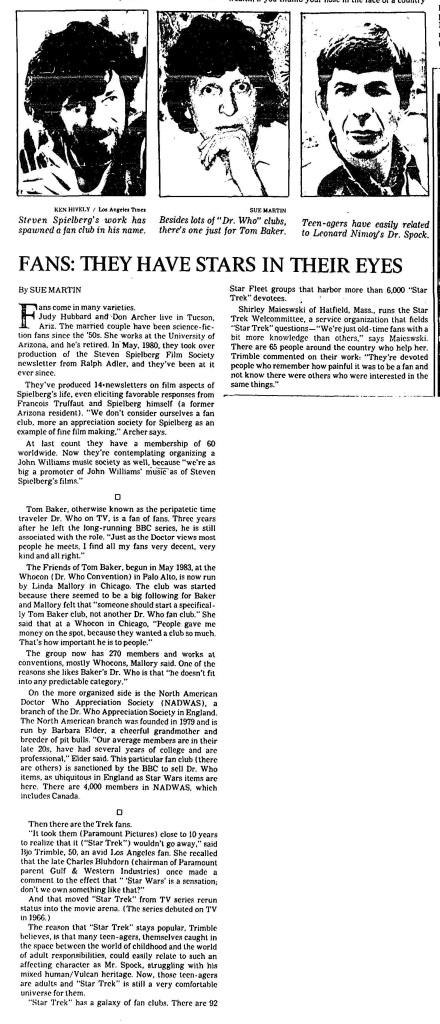Fans: They Have Stars In Their Eyes
- Publication: Los Angeles Times
- Date: 1984-06-12
- Author: Sue Martin
- Page: part 6, p. 4
- Language: English
Fans come in many varieties. Judy Hubbard and Don Archer live in Tucson, Ariz. The married couple have been science-fiction fans since the '50s. She works at the University of Arizona, and he's retired. In May, 1980. they took over production of the Steven Spielberg Film Society newsletter from Ralph Adler, and they've been at it ever since.
They've produced 14 newsletters on film aspects of Spielberg's life, even eliciting favorable responses from Francois Truffaut and Spielberg himself (a former Arizona resident). "We don't consider ourselves a fan club. more an appreciation society for Spielberg as an example of fine film making," Archer says.
At last count they have a membership of 60 worldwide. Now they're contemplating organizing a John Williams music society as well, because "we're as big a promoter of John Williams' music of Steven Spielberg's films."
Tom Baker, otherwise known as the peripatetic time traveler Dr. Who on TV, is a fan of fans. Three years after he left the long-running BBC series, he is still associated with the role. "Just as the Doctor views most people he meets, I find all my fans very decent, very kind and all right."
The Friends of Tom Baker, begun in May 1983, at the Whocon (Dr. Who Convention) in Palo Alto, is now run by Linda Mallory in Chicago. The club was started because there seemed to be a big following for Baker and Mallory felt that "someone should start a specifically Tom Baker club, not another Dr. Who fan club." She said that at a Whocon in Chicago, "People gave me money on the spot, because they wanted a club so much. That's how important he is to people."
The group now has 270 members and works at conventions, mostly Whocons, Mallory said. One of the reasons she likes Baker's Dr. Who is that "he doesn't fit into any predictable category."
On the more organized side is the North American Doctor Who Appreciation Society (NADWAS), a branch of the Dr. Who Appreciation Society in England. The North American branch was founded in 1979 and is run by Barbara Elder, a cheerful grandmother and breeder of pit bulls. "Our average members are in their late 20s, have had several years of college and are professional." Elder said. This particular fan club (there are others) is sanctioned by the BBC to sell Dr. Who items, as ubiquitous in England as Star Wars items are here. There are 4,000 members in NADWAS, which includes Canada.
Then there are the Trek fans.
"It took them (Paramount Pictures) close to 10 years to realize that it ("Star Trek") wouldn't go away," said Bjo Trimble, 50, an avid Los Angeles fan, She recalled that the late Charles Bluhdorn (chairman of Paramount parent Gulf & Western Industries) once made a comment to the effect that " 'Star Wars' is a sensation; don't we own something like that?"
And that moved "Star Trek" from TV series rerun status into the movie arena. (The series debuted on TV in 1966.)
The reason that "Star Trek" stays popular, Trimble believes, is that many teen-agers, themselves caught in the space between the world of childhood and the world of adult responsibilities, could easily relate to such an affecting character as Mr. Spock, struggling with his mixed human/Vulcan heritage. Now, those teen-agers arc adults and "Star Trek" is still a very comfortable universe for them.
"Star Trek" has a galaxy of fan clubs. There are 92 Star Fleet groups that harbor more than 6,000 "Star Trek" devotees.
Shirley Maieswski of Hatfield, Mass., runs the Star Trek Welcommittee, a service organization that fields "Star Trek" questions—"We're just old-time fans with a bit more knowledge than others," says Maieswski. There are 65 people around the country who help her. Trimble commented on their work: "They're devoted people who remember how painful it was to be a fan and not know there were others who were interested in the same things."
Caption: Steven Spielberg's work has spawned a fan club in his name.
Caption: Besides lots of "Dr. Who" clubs, there's one just for Tom Baker.
Caption: Teen-agers have easily related to Leonard Nimoy's Dr. Spock.
Disclaimer: These citations are created on-the-fly using primitive parsing techniques. You should double-check all citations. Send feedback to whovian@cuttingsarchive.org
- APA 6th ed.: Martin, Sue (1984-06-12). Fans: They Have Stars In Their Eyes. Los Angeles Times p. part 6, p. 4.
- MLA 7th ed.: Martin, Sue. "Fans: They Have Stars In Their Eyes." Los Angeles Times [add city] 1984-06-12, part 6, p. 4. Print.
- Chicago 15th ed.: Martin, Sue. "Fans: They Have Stars In Their Eyes." Los Angeles Times, edition, sec., 1984-06-12
- Turabian: Martin, Sue. "Fans: They Have Stars In Their Eyes." Los Angeles Times, 1984-06-12, section, part 6, p. 4 edition.
- Wikipedia (this article): <ref>{{cite news| title=Fans: They Have Stars In Their Eyes | url=http://cuttingsarchive.org/index.php/Fans:_They_Have_Stars_In_Their_Eyes | work=Los Angeles Times | pages=part 6, p. 4 | date=1984-06-12 | via=Doctor Who Cuttings Archive | accessdate=3 July 2025 }}</ref>
- Wikipedia (this page): <ref>{{cite web | title=Fans: They Have Stars In Their Eyes | url=http://cuttingsarchive.org/index.php/Fans:_They_Have_Stars_In_Their_Eyes | work=Doctor Who Cuttings Archive | accessdate=3 July 2025}}</ref>
